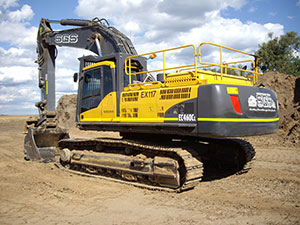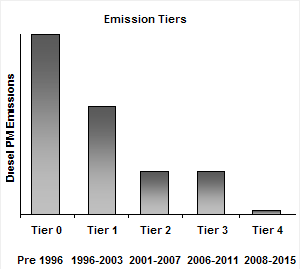Non-road diesel and marine emissions
Construction and mining equipment, rail locomotives, ports equipment and ships can all have diesel engines - a significant source of air pollution. Here’s what we’re doing to reduce these diesel emissions, and why it’s so important.
Action is crucial due to the growth in particle pollution from this sector, increasing evidence of adverse health impacts, and the availability of proven technologies to reduce diesel emissions.

Pollution from non-road diesel engines
The non-road emissions sector covers
- diesel-powered construction and mining equipment
- rail locomotives
- ports equipment
- ships
Diesel engines are significant sources of fine particle and other types of air pollution. Many diesel engines, such as those in construction equipment, locomotives and cruise ships, operate in populated areas, which leads to higher exposure to emissions and greater health consequences for workers and residents.
In the NSW Greater Metropolitan Region alone
- there are around 100,000 or 15% of Australia's non-road diesel engines
- around 9,000 new engines are purchased every year
- non-road diesel engines account for about 5–10% of fine particle pollution
- according to the 2008 Air Emissions Inventory, more than 90% of non-road diesel fine particle emissions come from non-road vehicles and equipment, shipping and rail transport
Fine-particle emissions from diesel exhaust can be inhaled deep into the lungs and have been declared a carcinogen by the World Health Organization’s International Agency for Research on Cancer. Find out more about health effects of fine particle pollution at About air pollution and Managing particle pollution.
While on-road diesel engines sold in Australia, such as those for trucks and buses, are regulated to meet strict emission limits, there are no regulations to control emissions from non-road diesel engines. Such regulations have been enforced in the United States and the European Union since the mid-1990s and, more recently, in Canada, Russia, Switzerland, Turkey, Japan, China, India, South Korea, Singapore and Brazil.

The US Environment Protection Agency (US EPA) emission standards are expressed as tiers and European Commission (EC) standards are expressed as stages, with progressively tighter emission standards phased-in for different size engines. The graph shows the reduction in particle emissions as the US standards have been increasingly tightened. Currently, all new diesel equipment in the US must conform to Tier 3 or Tier 4 standards.
A 2009 survey of new engines purchased in Australia indicated that around 80% conformed to US EPA Tier 2 standard or below.
The Cleaner non-road diesel engine project - identification and recommendation of measures to support the uptake of cleaner non-road diesel engines in Australia was funded by the NSW and Commonwealth governments and published in 2010. The report found that nationally:
- significant health benefits can be achieved by implementing national standards for emissions from non-road diesel engines and equipment
- annual health savings from PM10 and NOx emissions reductions were estimated to be from $2.5 to $4.7 billion by 2030
- particle-emission reductions by complying with the latest US standards were estimated to be between 5,600 and 10,200 tonnes per annum in 2020, increasing to 7,300-14,100 tonnes per annum in 2030
- all non-road diesel engines are imported, and in the absence of national emissions standards there is a risk that continued voluntary uptake of cleaner engines could decline in the face of cheaper, non-compliant imports for some engine categories.
In February 2019, the NSW Government released its updated Resource Efficiency Policy (GREP).
The policy, administered by the Office of Environment and Heritage, requires that all agencies purchasing, leasing, or procuring contractor-supplied mobile non-road diesel plant and equipment, apply a minimum performance standard
- US EPA Tier 4 or EU Stage IIIA/IIIB/IV compliant (depending on engine size)
- US EPA Tier 4 or EU Stage V compliant from 2021 or 2022 (depending on engine size).
(See Appendix C of the GREP for engine size details.)
In addition, to encourage the use of cleaner leased machinery and contractors’ machines, NSW Government agencies are to include a weighting to preference low emission engines in their tender selection process; a requirement in procurement contracts to report engine conformity; or require contractors to specify how they will reduce air emissions and provide data on the air emissions from their equipment.
Developing a national approach to reducing emissions from non-road diesel engines may be a lengthy process and national emissions standards will not address pollution from existing fleets, which have long working lives. To help reduce diesel exhaust emissions now, the following strategies can be applied
- purchase engines that conform with the highest available US, EU or equivalent international standards
- ensure any fuel used conforms with the national diesel fuel quality standard
- ensure engines are correctly repaired and maintained
- improve an engine’s emission performance by fitting it with an anti-pollution control device
- restrict unnecessary engine idling
- locate plant and equipment away from sensitive populations (e.g. schools, hospitals, childcare facilities) and/or use lowest emissions equipment near these areas
- locate plant and equipment away from residential areas and restrict access to essential vehicles and machinery only
- avoid the onsite use of diesel- or petrol-powered generators by substituting mains electricity or battery powered equipment where possible.